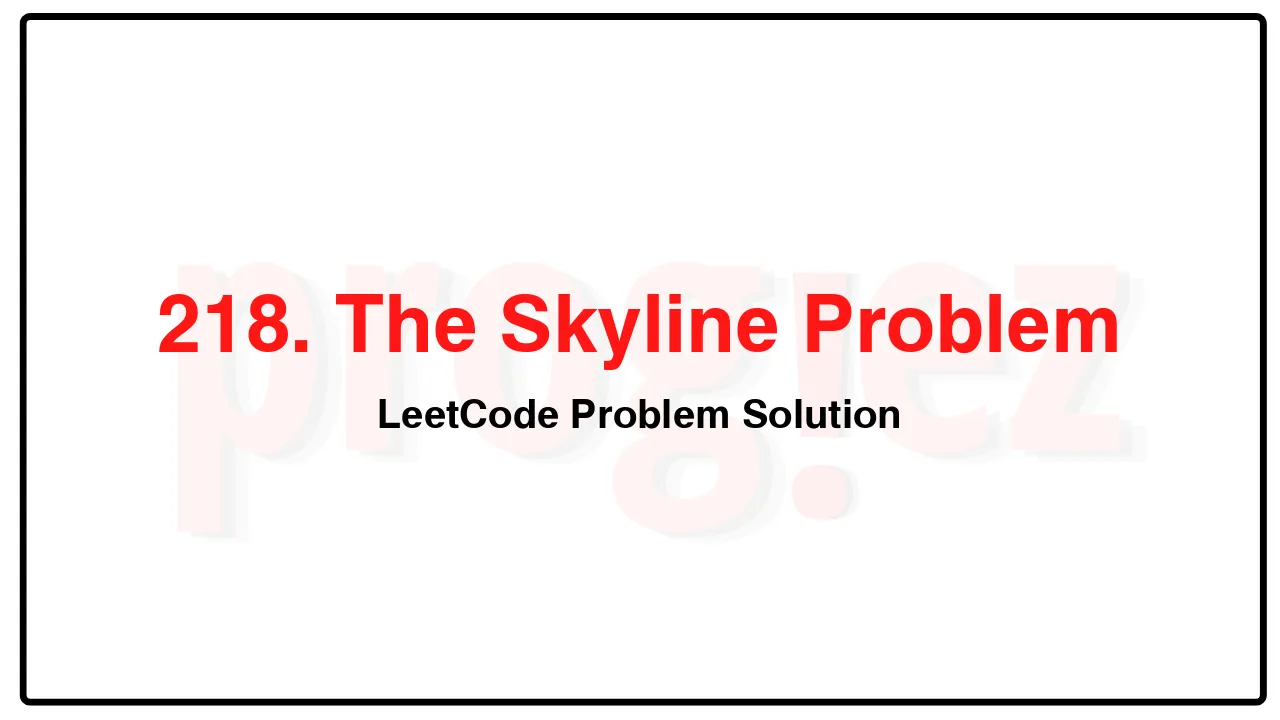218. The Skyline Problem LeetCode Solution
In this guide, you will get 218. The Skyline Problem LeetCode Solution with the best time and space complexity. The solution to The Skyline Problem problem is provided in various programming languages like C++, Java, and Python. This will be helpful for you if you are preparing for placements, hackathons, interviews, or practice purposes. The solutions provided here are very easy to follow and include detailed explanations.
Table of Contents
- Problem Statement
- Complexity Analysis
- The Skyline Problem solution in C++
- The Skyline Problem solution in Java
- The Skyline Problem solution in Python
- Additional Resources

Problem Statement of The Skyline Problem
A city’s skyline is the outer contour of the silhouette formed by all the buildings in that city when viewed from a distance. Given the locations and heights of all the buildings, return the skyline formed by these buildings collectively.
The geometric information of each building is given in the array buildings where buildings[i] = [lefti, righti, heighti]:
lefti is the x coordinate of the left edge of the ith building.
righti is the x coordinate of the right edge of the ith building.
heighti is the height of the ith building.
You may assume all buildings are perfect rectangles grounded on an absolutely flat surface at height 0.
The skyline should be represented as a list of “key points” sorted by their x-coordinate in the form [[x1,y1],[x2,y2],…]. Each key point is the left endpoint of some horizontal segment in the skyline except the last point in the list, which always has a y-coordinate 0 and is used to mark the skyline’s termination where the rightmost building ends. Any ground between the leftmost and rightmost buildings should be part of the skyline’s contour.
Note: There must be no consecutive horizontal lines of equal height in the output skyline. For instance, […,[2 3],[4 5],[7 5],[11 5],[12 7],…] is not acceptable; the three lines of height 5 should be merged into one in the final output as such: […,[2 3],[4 5],[12 7],…]
Example 1:
Input: buildings = [[2,9,10],[3,7,15],[5,12,12],[15,20,10],[19,24,8]]
Output: [[2,10],[3,15],[7,12],[12,0],[15,10],[20,8],[24,0]]
Explanation:
Figure A shows the buildings of the input.
Figure B shows the skyline formed by those buildings. The red points in figure B represent the key points in the output list.
Example 2:
Input: buildings = [[0,2,3],[2,5,3]]
Output: [[0,3],[5,0]]
Constraints:
1 <= buildings.length <= 104
0 <= lefti < righti <= 231 – 1
1 <= heighti <= 231 – 1
buildings is sorted by lefti in non-decreasing order.
Complexity Analysis
- Time Complexity: O(n\log n)
- Space Complexity: O(n)
218. The Skyline Problem LeetCode Solution in C++
class Solution {
public:
vector<vector<int>> getSkyline(const vector<vector<int>>& buildings) {
const int n = buildings.size();
if (n == 0)
return {};
if (n == 1) {
const int left = buildings[0][0];
const int right = buildings[0][1];
const int height = buildings[0][2];
return {{left, height}, {right, 0}};
}
const vector<vector<int>> left =
getSkyline({buildings.begin(), buildings.begin() + n / 2});
const vector<vector<int>> right =
getSkyline({buildings.begin() + n / 2, buildings.end()});
return merge(left, right);
}
private:
vector<vector<int>> merge(const vector<vector<int>>& left,
const vector<vector<int>>& right) {
vector<vector<int>> ans;
int i = 0; // left's index
int j = 0; // right's index
int leftY = 0;
int rightY = 0;
while (i < left.size() && j < right.size())
// Choose the point with the smaller x.
if (left[i][0] < right[j][0]) {
leftY = left[i][1]; // Update the ongoing `leftY`.
addPoint(ans, left[i][0], max(left[i++][1], rightY));
} else {
rightY = right[j][1]; // Update the ongoing `rightY`.
addPoint(ans, right[j][0], max(right[j++][1], leftY));
}
while (i < left.size())
addPoint(ans, left[i][0], left[i++][1]);
while (j < right.size())
addPoint(ans, right[j][0], right[j++][1]);
return ans;
}
void addPoint(vector<vector<int>>& ans, int x, int y) {
if (!ans.empty() && ans.back()[0] == x) {
ans.back()[1] = y;
return;
}
if (!ans.empty() && ans.back()[1] == y)
return;
ans.push_back({x, y});
}
};
/* code provided by PROGIEZ */218. The Skyline Problem LeetCode Solution in Java
class Solution {
public List<List<Integer>> getSkyline(int[][] buildings) {
final int n = buildings.length;
if (n == 0)
return new ArrayList<>();
if (n == 1) {
final int left = buildings[0][0];
final int right = buildings[0][1];
final int height = buildings[0][2];
List<List<Integer>> ans = new ArrayList<>();
ans.add(new ArrayList<>(List.of(left, height)));
ans.add(new ArrayList<>(List.of(right, 0)));
return ans;
}
List<List<Integer>> leftSkyline = getSkyline(Arrays.copyOfRange(buildings, 0, n / 2));
List<List<Integer>> rightSkyline = getSkyline(Arrays.copyOfRange(buildings, n / 2, n));
return merge(leftSkyline, rightSkyline);
}
private List<List<Integer>> merge(List<List<Integer>> left, List<List<Integer>> right) {
List<List<Integer>> ans = new ArrayList<>();
int i = 0; // left's index
int j = 0; // right's index
int leftY = 0;
int rightY = 0;
while (i < left.size() && j < right.size())
// Choose the point with the smaller x.
if (left.get(i).get(0) < right.get(j).get(0)) {
leftY = left.get(i).get(1); // Update the ongoing `leftY`.
addPoint(ans, left.get(i).get(0), Math.max(left.get(i++).get(1), rightY));
} else {
rightY = right.get(j).get(1); // Update the ongoing `rightY`.
addPoint(ans, right.get(j).get(0), Math.max(right.get(j++).get(1), leftY));
}
while (i < left.size())
addPoint(ans, left.get(i).get(0), left.get(i++).get(1));
while (j < right.size())
addPoint(ans, right.get(j).get(0), right.get(j++).get(1));
return ans;
}
private void addPoint(List<List<Integer>> ans, int x, int y) {
if (!ans.isEmpty() && ans.get(ans.size() - 1).get(0) == x) {
ans.get(ans.size() - 1).set(1, y);
return;
}
if (!ans.isEmpty() && ans.get(ans.size() - 1).get(1) == y)
return;
ans.add(new ArrayList<>(List.of(x, y)));
}
}
// code provided by PROGIEZ218. The Skyline Problem LeetCode Solution in Python
class Solution:
def getSkyline(self, buildings: list[list[int]]) -> list[list[int]]:
n = len(buildings)
if n == 0:
return []
if n == 1:
left, right, height = buildings[0]
return [[left, height], [right, 0]]
left = self.getSkyline(buildings[:n // 2])
right = self.getSkyline(buildings[n // 2:])
return self._merge(left, right)
def _merge(self, left: list[list[int]],
right: list[list[int]]) -> list[list[int]]:
ans = []
i = 0 # left's index
j = 0 # right's index
leftY = 0
rightY = 0
while i < len(left) and j < len(right):
# Choose the powith smaller x
if left[i][0] < right[j][0]:
leftY = left[i][1] # Update the ongoing `leftY`.
self._addPoint(ans, left[i][0], max(left[i][1], rightY))
i += 1
else:
rightY = right[j][1] # Update the ongoing `rightY`.
self._addPoint(ans, right[j][0], max(right[j][1], leftY))
j += 1
while i < len(left):
self._addPoint(ans, left[i][0], left[i][1])
i += 1
while j < len(right):
self._addPoint(ans, right[j][0], right[j][1])
j += 1
return ans
def _addPoint(self, ans: list[list[int]], x: int, y: int) -> None:
if ans and ans[-1][0] == x:
ans[-1][1] = y
return
if ans and ans[-1][1] == y:
return
ans.append([x, y])
# code by PROGIEZAdditional Resources
- Explore all LeetCode problem solutions at Progiez here
- Explore all problems on LeetCode website here
Happy Coding! Keep following PROGIEZ for more updates and solutions.









